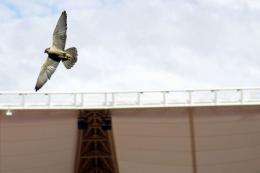Raptors guard S.African World Cup stadium

A South African World Cup stadium has turned to birds of prey to chase out rogue pigeons and rats in an anti-pest strategy that favours raptors above the pitch instead of poisons.
The new 46,000-seat stadium in coastal Port Elizabeth sports several bird and bat boxes under the outer eaves of its striking petal-shaped roof to draw aerial hunters.
"We've gone completely poison free. This is the only stadium with a programme like this in place as a pest deterrent," stadium manager Rob Hichens told AFP.
The strategy was designed as a harmonious system: the wild raptors hunt and chase away feral pigeons, eliminating the notoriously slovenly birds' nests and droppings which attract rats.
"Pigeons are extremely messy. The whole of town is riddled with them. I did a feral pigeon count in town and we've got over 10,000 birds," said Arnold Slabbert of the Urban Raptor Project, who drew up the pest strategy.
The birds carry lice and diseases in their faeces which damage seats while rats eat the droppings and raid the nests for eggs and chicks, he said.
"Immediately you are allowing a big pigeon problem to develop, you are causing a rat problem to start as well. You don't want pigeons in a stadium, end of story."
The raptors can be seen soaring above the two billion rand (208 million euro, 264 million dollar) stadium, which overlooks a lake near the city's central business district, while wagtails are spotted feeding off insects on the pitch
"At the moment, three African peregrine falcons live in the stadium. They hunt quite extensively," he said.
"They're extremely effective at controlling the pigeon population. The pigeons don't come near the stadium, they just stay away. It's an amazing deterrent."
Bat boxes were also erected in trees and under the outer stadium roof for indigenous bats -- which can eat 132 mosquitos an hour -- drawn by insects attracted by the stadium's lights and its lake setting.
And plans are afoot to introduce indigenous grass-eating rats in the surrounding marshy areas to provide food for hunting rock kestrels to draw them to the stadium, which has no rat problem, said Slabbert.
"I look at an integrated control of all pest species. I'm creating a complete little ecosystem here," he said.
A hand-reared larger falcon is brought in to chase away crows, which pick on electrical wires and whose roosts can number around 100 birds, and a would-be red wing starling residence has also been chased out of the stadium.
Slabbert was approached to identify potential bird problems during the three years it took to build the stadium, and he has set up similar projects in the area.
"It's the only World Cup stadium that does this and it's the only World Cup stadium that definitely doesn't have a bird problem," said Slabbert.
(c) 2010 AFP
















